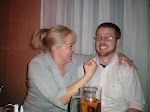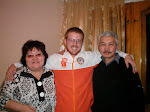This past week was the second Easter I had spent outside of the States. Now, for all of you aware of religious holidays, you might be thinking, Last week?! We had Easter, complete with egg-laying rabbits and sugar overdoses, a month ago! But I am blessed to have been placed in a country with a high population of Russian Orthodox believers who follow a different religious calendar. As in the US, Easter comes with a slew of traditions and customs and I made a point to see and participate in a few of them.
The first tradition, which takes place before the actual day of Easter, involves eggs and sweets, much like at home. We bought eggs and dye to colorfully decorate the eggs (although each egg was one solid color without creative designs) and applied stickers to complete the effect of festive new birth, although there is no rabbit involved in any way. The cakes we bought were grapefruit-sized and confetti-ed and bear the name “Pasxa” which is also the name for “Easter”. Orthodox church-goers go on Saturday to the church to have their cakes, eggs and whatever other food products they want blessed by the priest. Dressed in all black with altar boys in tow, the priest walks up and down the long tables set up outside the main sanctuary where people have set out their goodies. The crowd is predominantly women, and I’d say the average age of all those present had to be close to 50. The priest sings a blessing while splashing the table and the people behind it with lashes of holy water thrown from a tassel-esque brush. In his other hand he carries a 9-inch gold cross that he holds forward for everyone to kiss as he comes by. His assistants follow him carrying several baskets – the first for monetary donations and several others for edibles. Each person takes a portion of what they brought and adds it to the batch. After we had our blessed foodstuffs repacked into bags, Natasha, Marina, Tim and I took a tour of the church itself. The church we visited was smaller than most, but like the others in general appearance, having white and yellow walls, a green roof and several gold domes adorned with crosses. The inside consisted only of one room with many small shrines, each housing an icon and a metal stand for candles. As we walked around to the different icons, many of which were obviously very old, my host mom explained that you should pray to each icon for specific purposes: one for your children, another for health, and another for travel and work. You could then buy small candles in the office to light and place in the metal stand. I learned to appropriately cross myself – Orthodox do it similar to Catholics, but in an Up-Down-Right-Left order instead of Up-Down-Left-Right – when both entering and leaving each threshold you pass (there were four including the gate outside).
The second tradition, which I opted not to participate in, was a midnight vigil at the same church, beginning 12:01 on Easter morning and lasting until sunrise. I thought that it might be rude to come and leave after a few minutes, or even an hour, but didn’t quite want to stand still all night for six or more hours.
The day of Easter was a whole separate mess of events. I woke up at 9:30 planning to go play soccer with some local friends at 10:00, only to find a "prasnichny stol" or “celebration table” set up in the living room. Natasha greeted me, and explained how you should say “Kristos voscres” (He is risen) to greet people, and that they should reply “Vaeestinu voscres” (He is risen indeed), followed by three alternating kisses on the cheek. Tim had spent the night and got up a few minutes later, receiving the same greeting I got just earlier. She said that we should sit and enjoy the eggs and cakes from the day before. However, before eating the eggs you should (naturally, as on any family orientated religious holiday) do battle. We picked our egg of choice and on the count of three hit them together. The owner of the egg that remains intact is said to enjoy good luck in the coming months as well as to be an expert egg-dueling master. I dispatched my host mother and Tim in the same breath, and basked in my glorious moments of victory. Just then, my doorbell rang announcing Mike’s arrival. After the greetings and the kissing, he was promptly challenged by Tim, Natasha, and me. I didn’t know that I should have been scared, but Mike put my dueling skills to shame, defeating all three of us, as well as later my host sister and another guest that came later. Maladyets, Mike. Maladyets.
By 10:15 breakfast was about done and I thought I might be able to sneak on out to soccer a little late, but my mom told us to sit tight while she pulled a chicken out of the oven and brought out the wine and vodka. Oh boy. Needless to say, I didn’t play soccer that day. We toasted to Jesus (He turned water to wine, not the other way around, right?), to health, to friendship, to love, to us, and even to you. We spent the rest of the day walking around the city, with a few stops to eat again or buy another drink. It’s nice to be acclimatizing to the local culture and to see all the different parts to a different take on a familiar holiday complete with Orthodox icons, colored eggs, duels, greetings, friends and family, food and vodka.
Subscribe to:
Post Comments (Atom)
.jpg)








2 comments:
Hi, Phil.
You mention that the Russian church in Petropavlovsk was one room with many small altars. Actually, those were shrines. There's only one altar, and it's behind the ikon screen at the front (east end) of the church.
a friend
Felipe,
Great post; as always, thanks for all the detail!
Because I have a Greek-American bro-in-law, his wife (a generally non-observant Christian) celebrates the 2x2 Western- and Eastern-rite Easters and Christmases -- very festive.
The Easter rabbit/hare is believed to be a symbol of fertility and new life of 16c German folkloric origin (but no known imprimatur from Martin Luther, which is just as well).
Post a Comment